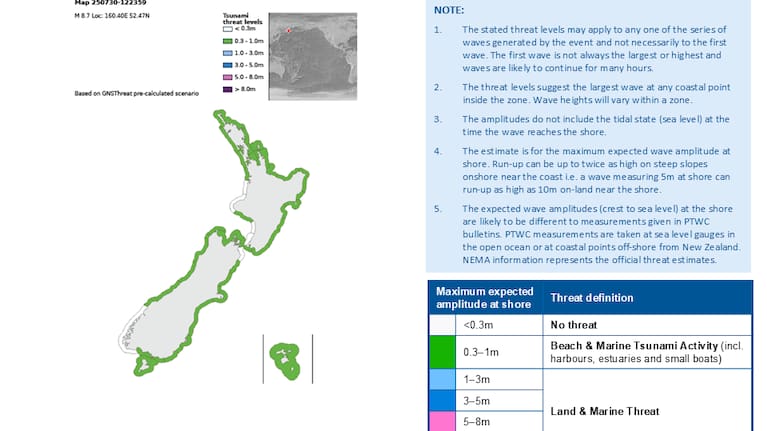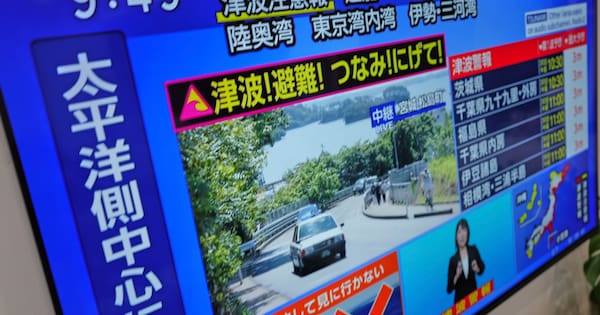New Zealand can expect “strong and unusual currents” and “unpredictable surges” at the shore following a powerful 8.8 magnitude earthquake off Russia’s far east this morning, the National Emergency Management Agency (NEMA) says.
The US Geological Survey said the quake occurred at 11.25am near the Kamchatka Peninsula and registered a preliminary magnitude of 8.0, subsequently upgraded to 8.7 and then 8.8. It is the largest earthquake to occur anywhere on the planet since the 2011 Tōhoku earthquake in Japan and the first to be measured at a magnitude higher than 8 this year.
Russia, Japan, and the US states of Hawai’i and Alaska were under tsunami warnings.
NEMA earlier said there was no tsunami threat, but reassessed after the earthquake’s magnitude was upgraded.

“Strong currents and surges can injure and drown people. There is a danger to swimmers, surfers, people fishing, and anyone in or near the water close to shore,” NEMA said.
“People in or near the sea in the following areas should move out of the water, off beaches and shore areas and away from harbours, marinas, rivers and estuaries.”
Coastal inundation was not expected as a result of this event, NEMA added.
“Strong and unusual currents and unpredictable surges will continue for several hours and the threat must be regarded as real until this advisory is cancelled.”

Areas under threat
On the west coast of the North Island, impacts would be felt from Cape Reinga to Raglan, including the west coast of Auckland and Manukau Harbour, and from Hawera to Whanganui.
On the east and south coasts of the North Island, areas from Cape Reinga to Makara, including Whangārei, Great Barrier Island, the east coast of Auckland, Waiheke Island, Waitematā Harbour, Tauranga, Whakatāne, Ōpōtiki, Gisborne, Napier, Lake Ferry, the Wellington south coast and Wellington Harbour.
South Island’s west coast would be impacted from Farewell Spit to Milford Sound, including Westport, Greymouth and Hokitika.
At the top of the South Island, from Farewell Spit to Port Underwood, including Nelson, Picton and the Marlborough Sounds.
On the east and south coasts of the South Island from the Clarence River to Puysegur Point, including Kaikōura, Christchurch, Banks Peninsula, Timaru, Ōamaru, Dunedin, the Otago Peninsula and Invercargill.
Stewart Island and Chatham Islands were also impacted.
Coastal communities across the Pacific Ocean warned of tsunami and sea surges. (Source: 1News)
The impact of the tsunami could last for hours — such as in Adak, a community of about 70 people in Alaska’s Aleutian Islands — or perhaps more than a day, Snider said.
“A tsunami is not just one wave,” he said. “It’s a series of powerful waves over a long period of time. Tsunamis cross the ocean at hundreds of miles an hour — as fast as a jet airplane — in deep water. But when they get close to the shore, they slow down and start to pile up. And that’s where that inundation problem becomes a little bit more possible there.”
“In this case, because of the Earth basically sending out these huge ripples of water across the ocean, they’re going to be moving back and forth for quite a while,” which is why some communities may feel effects longer, he said.
The Pacific Tsunami Warning Centre in Honolulu said the tsunami generated by the quake could cause damage along the coastlines of all the Hawaiian islands.
“Urgent action should be taken to protect lives and property,” the warning stated. The first waves were expected around 7pm Tuesday (local time).
The Oregon Department of Emergency Management said on Facebook that small tsunami waves were expected along the coast starting around 11.40pm (local time), with wave heights between 30 to 60 centimetres. It urged people to stay away from beaches, harbours and marinas and to remain in a safe location away from the coast until the advisory is lifted.
“This is not a major tsunami, but dangerous currents and strong waves may pose a risk to those near the water,” the department said.
Russian regions report quake damage
The quake at 8.25am Japan time had a preliminary magnitude of 8.0, Japan and U.S. seismologists said. The US Geological Survey later updated its measurement to 8.8 magnitude and the USGS said the quake occurred at a depth of 20.7 kilometres.
The quake was centred about 119 kilometres east-southeast from the Russian city of Petropavlovsk-Kamchatsky, which has a population of 180,000, on the Kamchatka Peninsula. Multiple aftershocks as strong as 6.9 magnitude were recorded.
The first tsunami wave hit the coastal area of Severo-Kurilsk, the main settlement on Russia’s Kuril Islands in the Pacific, according to the local governor Valery Limarenko. He said residents were safe and staying on high ground until the threat of a repeat wave was gone.
The quake caused damage to buildings and cars swayed in the streets in Petropavlovsk-Kamchatsky, which also had power outages and mobile phone service failures. Russian news agencies quoting the regional Health Ministry saying several people sought medical help in Kamchatka after the earthquake, but no serious injuries were reported.
Among the world’s strongest recorded quakes
The earthquake appeared to be the strongest anywhere in the world since the March 2011 earthquake off northeast Japan that was 9.0 magnitude and caused a massive tsunami that set off meltdowns at a nuclear power plant. Only a few stronger earthquakes have ever been measured around the world.
The tsunami alert disrupted transportation in Japan. Ferries connecting Hokkaido and Aomori on the northern tip of Japan’s Honshu island were suspended, as well as those connecting Tokyo and nearby islands, and some local train operations were suspended or delayed, according to operators. Sendai airport temporarily closed its runway.
Japan’s Fire and Disaster Management Agency said so far no injuries or damages have been reported. The agency, in response to the tsunami alert, issued an evacuation advisory to more than 900,000 residents in 133 municipalities along Japan’s Pacific coast, from Hokkaido to Okinawa.
Japanese nuclear power plants reported no abnormalities. Tokyo Electric Power Company Holdings, which operates the tsunami-hit Fukushima Daiichi nuclear power plant, said about 4000 workers are taking shelter on higher ground at the plant complex while monitoring remotely to ensure plant safety.
Philippine authorities warned provinces and towns along the eastern coast facing the Pacific of possible tsunami waves of less than 1m and advised people to stay away from the beach and coastal areas.
“It may not be the largest of waves, but these can continue for hours and expose people swimming in the waters to danger,” Teresito Bacolcol of the Philippine Institute of Volcanology and Seismology told The Associated Press.
Mexico’s navy warned that tsunami waves will start reaching the northern coast in Ensenada, near California, at around 2.22am Wednesday (local time), and waves could progress along the Pacific coast to Chiapas state, around 7.15am (local time). The navy recommended people stay away from beaches until it suspended the alert.
They said that while the situation “was under control” there are risks of aftershocks, which could last for up to a month and warned against visiting certain coastal areas.
Earlier in July, five powerful quakes — the largest with a magnitude of 7.4 — struck in the sea near Kamchatka. The largest quake was at a depth of 20 kilometres and was 144 kilometres east of the city of Petropavlovsk-Kamchatsky.
On November 4, 1952, a magnitude 9.0 quake in Kamchatka caused damage but no reported deaths despite setting off 9.1m waves in Hawaii.

